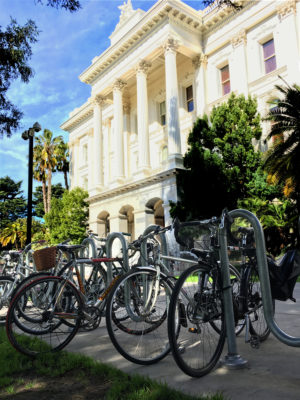Last fall, a legislative report concluded that regional efforts to reduce greenhouse gas emissions are not working.
Dubbed the "S.B. 150" report because it was required by a 2017 bill, the California Air Resources Board report assessed progress towards state climate goals, identified best practices and challenges, and recommended some fixes.
Now a new bill, S.B. 526, from the author of S.B. 150, Senator Ben Allen (D-Santa Monica), will take up some of those recommendations.
S.B. 526 has four main components: the formation of an interagency work group, getting better data and reporting from MPOs, adding an implementation plan to existing regional Sustainable Communities Strategies, and aligning transportation funding with climate goals.
Let's start with the last one. Despite better fuel efficiency and cleaner fuels, greenhouse gas emissions from the transportation sector are rising. Even with incentives to grow the proportion of electric vehicles on the road, academic researchers and Air Resource Board scientists generally agree that the only way California can reach its climate goals is if everyone were to drive less. Not a lot less; the ARB estimates about seven percent below levels projected by best-case scenarios 2030, or about a mile and a half per person every day.
And despite every region preparing Sustainable Communities Strategies to discuss how they will reach climate goals, there is little evidence that regional funding has shifted in any measurable way. That is, the state continues investing in transportation projects that make driving easier, encouraging the use of private vehicles at the expense of, say, transit or bicycling or walking.
It's the legacy of a state highway department that for years had been on a mission to smooth traffic and make driving at high speeds safer for vehicle occupants--a mission that, despite attempts to shift it, maintains a tight hold on state agencies.
Those agencies include the California Transportation Commission, which is charged with allocating state transportation funding. CTC members have consistently pushed back on the notion that Californians should drive less, questioning why that is a reasonable measure of greenhouse gas emissions, for example. At its most recent meeting, one of the commissioners implied that they had no choice but to give the public what it wants. "The public is demanding more flexibility in transportation," said Commissioner Lucy Dunn. "Balancing climate goals versus the public expectation that they can get where they want to get to with the freedom they demand will be far harder than any of us can imagine."
S.B. 526 would realign spending priorities from the top, that is, at the state level. It would require Caltrans and the CTC to develop funding guidelines that take into account whether a region is achieving its greenhouse gas reduction targets. If it is not--and they are not--the commission would be required to give priority to projects that reduce vehicle travel and greenhouse gas emissions.
There would still be an inherent conflict between who is making decisions--on land use, for example, or planning for housing or transportation--and who is responsible for reducing emissions. So another part of the bill would create a new interagency working group to be led by the Strategic Growth Council. S.B. 526 calls for the SGC to develop a State Mobility Action Plan for Healthy Communities to study ways to design regional growth in alignment with other state goals including climate, equity, and housing goals. The SGC was created for this purpose anyway: to coordinate state agencies on issues such as water and air quality, transportation, and affordable housing. For example, the Council currently manages the Affordable Housing and Sustainable Communities program, which funds projects developed by disparate agencies to plan for and build affordable housing matched with sustainable transportation projects.
The bill's author has gone to some pains to refrain from dictating specific actions that local or regional governments must take to lower emissions. As with S.B. 375, the predecessor bill that originally called for regional plans to set greenhouse gas emission reduction goals, those actions would be left up to local governments. The bill contains no specific rules about density, growth boundaries, or other potentially controversial topics. Instead, it calls on local jurisdictions to create their own plans for achieving the goals they have already set out in their regional transportation plans.
The bill would not change who has authority over funding decisions. The regions would still report their progress on emissions reductions to the Air Resources Board, as they do now--although they may be required to produce different, and better, data. The ARB would determine whether the regions are meeting their goals or not, and report that information to the California Transportation Commission. It would be the CTC's job to reprioritize funding to regions that aren't meeting those goals.
The bill will be heard in three committees some time this spring: Environmental Quality, Transportation, and Housing.






